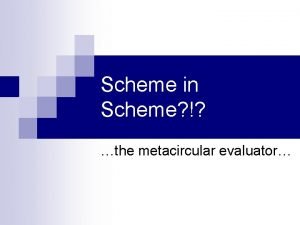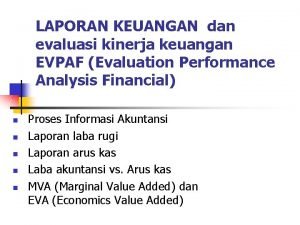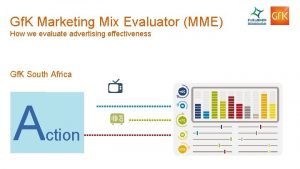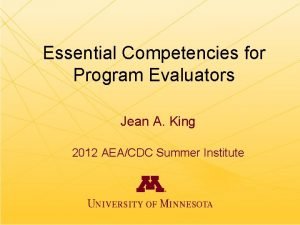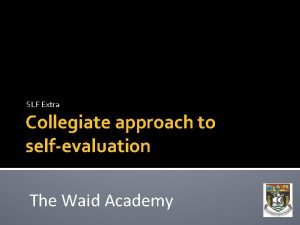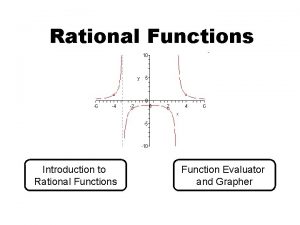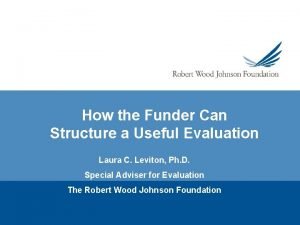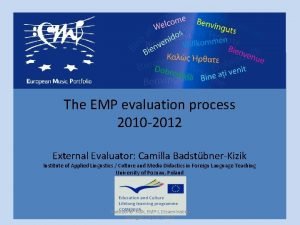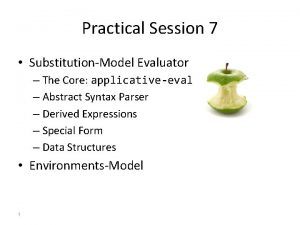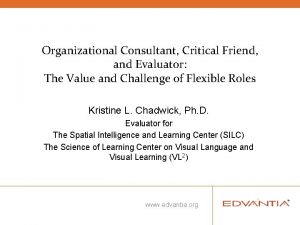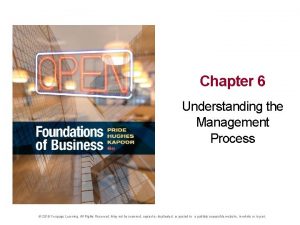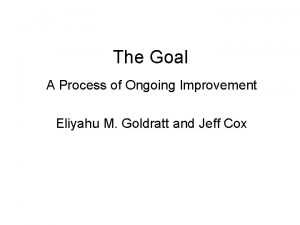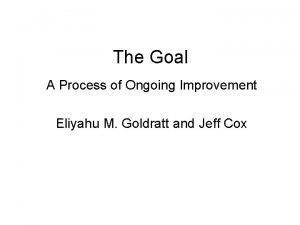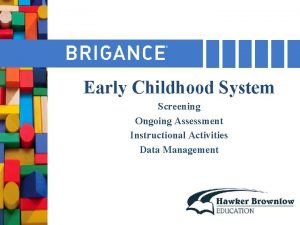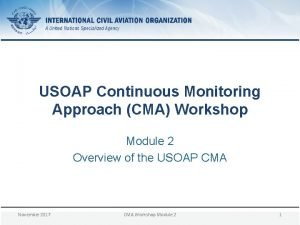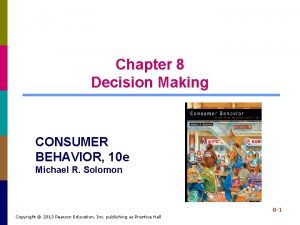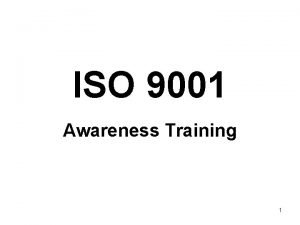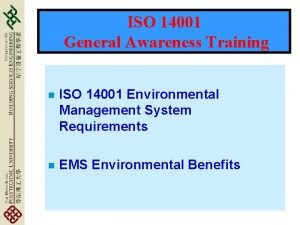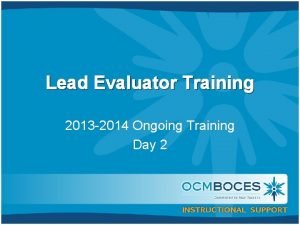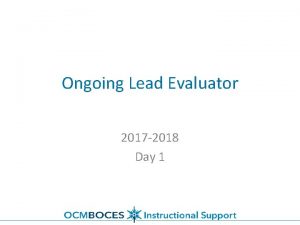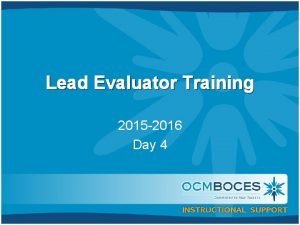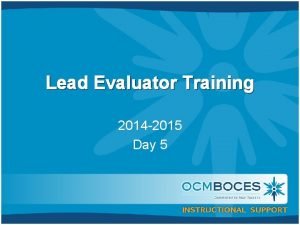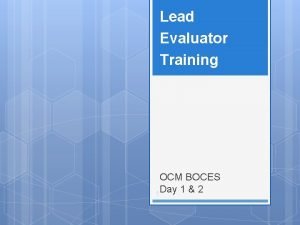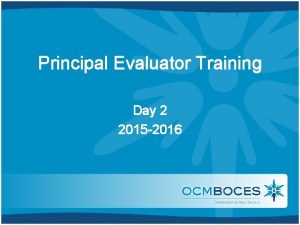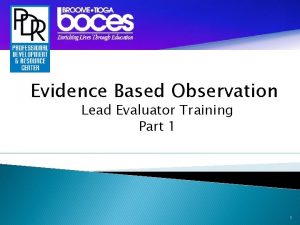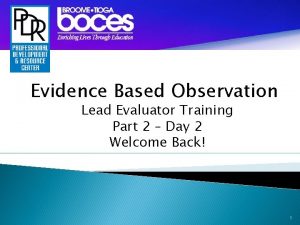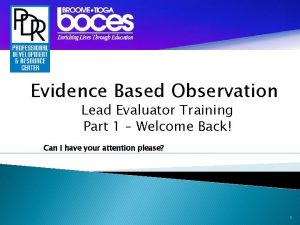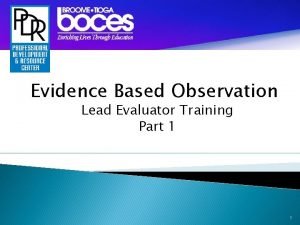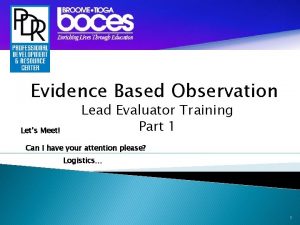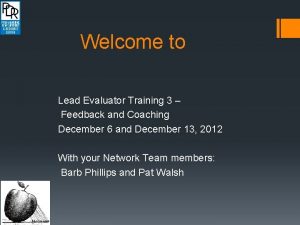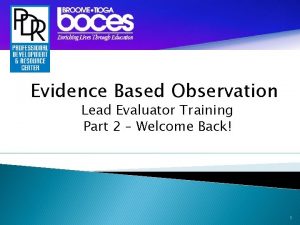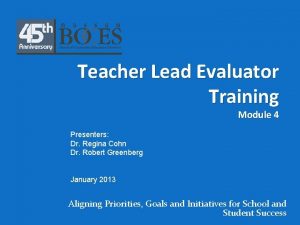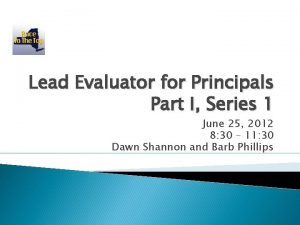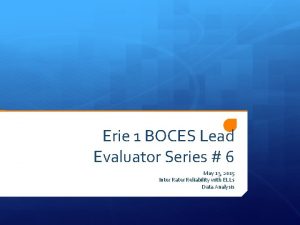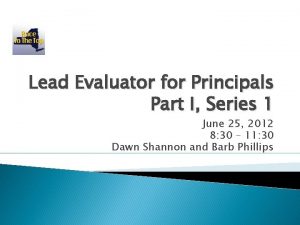Lead Evaluator Training 2015 2016 Ongoing Training Day








































- Slides: 40

Lead Evaluator Training 2015 -2016 Ongoing Training Day 3

Welcome to Day 3 • Lead Evaluator Training • Agenda Review

Nine Required Components 3012 -c 1. New York State Teaching Standards and Leadership Standards 2. Evidence-based observation 3. Application and use of Student Growth Percentile and VA Growth Model data 4. Application and use of the State-approved teacher or principal rubrics 5. Application and use of any assessment tools used to evaluate teachers and principals 3012 -d 1. New York State Teaching Standards and Leadership Standards 2. Evidence-based observation 3. Application and use of Student Growth Percentile method 4. Application and use of the State-approved teacher or principal rubrics 5. Application of assessment tools the district employs

Nine Required Components 3012 -c 6. Application and use of State-approved locally selected measures of student achievement 7. Use of the Statewide Instructional Reporting System 8. Scoring methodology used to evaluate teachers and principals 9. Specific considerations in evaluating teachers and principals of ELLs and students with disabilities 3012 -d 6. Application and use of State-approved locally selected measures of student growth 7. Use of the Statewide Instructional Reporting System 8. Scoring methodology used by the state and the district 9. Specific considerations in evaluating teachers and principals of ELLs and students with disabilities

Our Components 10. Managing the APPR (especially in d) 11. Connecting it to Learning 12. Increasing the likelihood that it makes a difference

Agenda • • Transition: § 3012 -c and § 3012 -d Research: Widget Effect Literature: Smorgasbord Evidence Collection & Scoring (with feedback) • Summative Evaluation (in light of the changes)

Warm Up Activity At your table, outline what the “transition” means for your teachers, THIS YEAR.

Warm Up Activity Worksheet: • Review each of the transition score scenarios. Determine the score(s) and rating(s) for each teacher or principal.

Research: Revising the Widget Effect

The Widget Effect • The New Teacher Project (2009) labeled the failure of systems to discriminate among teacher performance as “the Widget Effect. ” • Less than 1% of teachers rated unsatisfactory • But 81% of administrators and 57% of teachers could identify a teacher in their school that was unsatisfactory

The Widget Effect • Findings led to changing evaluation practices • Influenced RTTT requirements • Many states changed their practices

The Widget Effect - REVISITED • 2. 7% rated below satisfactory • Evaluators estimate 27. 8% below satisfactory • Evaluators expected fewer unsatisfactory ratings than were deserved going in

The Widget Effect - REVISITED • Reasons for inflation: – Factoring in potential – Personal discomfort – It could be worse – Skewed systems

The Widget Effect - REVISITED • Reasons for inflation: – Factoring in potential – Personal discomfort – Lack of faith in the overall system – Disagreement with foundation – It could be worse – Skewed district-determined scoring systems

The Widget Effect - REVISITED • Local Research Project – Please fill in information about your school or district and leave it behind. – Anonymous survey

Three-Minute Pause

Literature: Smorgasbord

Article Read & Share 1. 2. 3. 4. Look the articles over Choose one that interests you Read it Take turns discussing when all done

Article Read & Share Identify the connection between the different article that your table read ?

Evidence Collection Practice

Evidence Collection Practice ELA Lesson 1. Watch it (mini) 2. Collect evidence, clean it up, sort, etc. 3. Score on the provided rubric: Classroom environment focus 4. Check out inter-rater reliability

Standard IV: Learning Environment • Teachers work with all students to create a dynamic learning environment that supports achievement and growth.

Element IV. 1 Teachers create a mutually respectful, safe, and supportive learning environment that is inclusive of every student. a. Teachers are caring and respectful in their interactions with students. b. Teachers embrace student diversity as an asset in the classroom. c. Teachers recognize and reinforce positive interactions among students. d. Teachers create a climate of acceptance and respect. e. Teachers create an environment where students show responsibility to and for one another.

Element IV. 2 Teachers create an intellectually challenging and stimulating learning environment. a. Teachers encourage students to set high standards and expectations for their own performance. b. Teachers motivate students to initiate their own learning and strive to achieve challenging learning goals. c. Teachers promote students’ curiosity and enthusiasm for learning. d. Students are actively engaged in learning. e. Students openly express their ideas. f. Students show pride in their work and accomplishments

Element IV. 3 Teachers manage the learning environment for the effective operation of the classroom. a. Teachers establish, communicate, and maintain clear standards and expectations for student behavior. b. Teachers develop, implement, and adapt routines and procedures to manage activities and transitions. c. Teachers facilitate instructional groupings to maximize student participation, cooperation, and learning. d. Students exhibit respectful classroom interactions.

Element IV. 4 Teachers organize and utilize available resources (e. g. , physical space, time, people, technology) to create a safe and productive learning environment. a. Teachers arrange and adapt the physical environment to accommodate individual and group learning needs and to celebrate student accomplishments. b. Teachers ensure that all students have equitable access to available resources and technologies. c. Teachers effectively use the services and skills of available volunteers and paraprofessionals. d. Teachers know and implement policies and procedures to ensure student safety.

Evidence Collection Practice

Scoring 1. Compare your evidence 2. Look at the rubric, decide what you can score (probably not everything) 3. Determine a score for those items

Feedback What kind of feedback would you provide this teacher? • Discuss at your table. • Plan, especially, your opening line.

Connect Back Make a connection between the conversation you want to have with the teacher and one (or more) of the articles we read today.

Preparing for the Summative Evaluation

O I IT Preparing for the Summative Evaluation S N A R T N

Summative Evaluation • • O I IT SLO scoring conversion LAT scoring conversion Rubric scaling to 60 points Total Score > HEDI scale Growth-Producing Feedback PD recommendations Improvement Plan Requirements S N A R T N

C in Transition

D in Transition

One Last Transition Practice • 4 th grade classroom teacher • Combined ELA and math growth score from state 13 pts • For LAT, 2/3 of students met the target on the 4 th grade science test • Rubric score of 3. 2 translates to 55 pts

Closure Activity

Next Year • Year One Cohort for New Administrators? Likely? • Ongoing Training (need your input) – Likely 3 sessions – Timing similar to last year? – Four repeats to choose from? – What else?

Closure: Next Year On note paper, write a quick letter to Jeff about what you would like to see included in or changed for Dear Lead Evaluator Training, Je ff: NEXT YEAR. Leave it at your table.

Lead Evaluator Training See you next year!
 Day 1 day 2 day 3 day 4
Day 1 day 2 day 3 day 4 Veriforce oq evaluator
Veriforce oq evaluator Day 1 day 2 day 817
Day 1 day 2 day 817 Metacircularity
Metacircularity Financial evaluator adalah
Financial evaluator adalah Marketing mix evaluator
Marketing mix evaluator Evaluator competencies
Evaluator competencies Ehtc governing system
Ehtc governing system Excel formula evaluator
Excel formula evaluator Extracollegiate
Extracollegiate Rational functions grapher
Rational functions grapher Evaluator eol
Evaluator eol Emp moodle
Emp moodle External evaluator
External evaluator External evaluator
External evaluator Ongoing professional practice evaluation template
Ongoing professional practice evaluation template The process of evaluating and regulating ongoing activities
The process of evaluating and regulating ongoing activities Present continuous tense and past continuous tense
Present continuous tense and past continuous tense Planning phase of the nursing process
Planning phase of the nursing process Potential nursing diagnosis
Potential nursing diagnosis Herbie the goal
Herbie the goal The goal: a process of ongoing improvement
The goal: a process of ongoing improvement Ongoing or on-going
Ongoing or on-going Ongoing assessment early childhood
Ongoing assessment early childhood Usoap cma
Usoap cma Construction work ongoing
Construction work ongoing Stages in consumer decision making process
Stages in consumer decision making process On-going assessment
On-going assessment Lead magnesium niobate
Lead magnesium niobate Iso 9001:2015 awareness training ppt
Iso 9001:2015 awareness training ppt Iso 9001:2015 management review meeting presentation ppt
Iso 9001:2015 management review meeting presentation ppt Iso 14001 2015 awareness training
Iso 14001 2015 awareness training William beanes elementary school
William beanes elementary school Oceans apart day after day
Oceans apart day after day Day to day maintenance
Day to day maintenance Physical science chapter 6 review answers
Physical science chapter 6 review answers I don't know about tomorrow i just live from day to day
I don't know about tomorrow i just live from day to day What happens on sunday in romeo and juliet
What happens on sunday in romeo and juliet Growing day by day
Growing day by day Observation of seed germination day by day
Observation of seed germination day by day Conclusion of seeds
Conclusion of seeds



